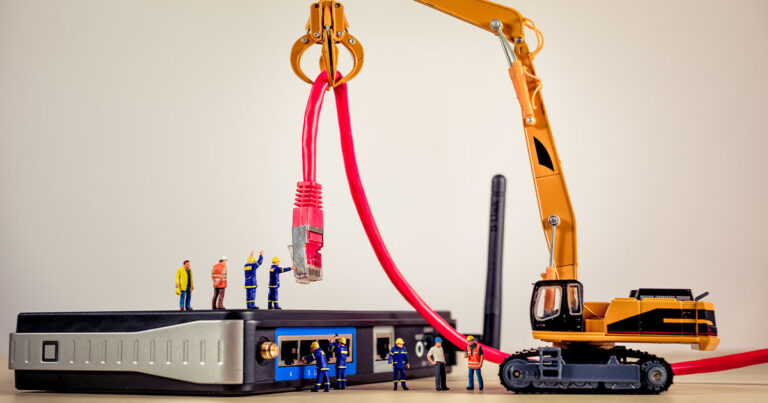If you’re in a home that can tap into speeds beyond NBN 100, there are some key gear requirements to consider.
Essential hardware for getting NBN 250 and 1000 speeds
Not so long ago, NBN 25 used to be called NBN Standard. This was reflective of the popularity, accessibility and ubiquity of one of the entry-level NBN plan speed tiers capable of 25Mbps max download speeds. Fast-forward to today, and NBN 50 is the new NBN Standard, both in name and popularity, which has double the download speed potential (50Mbps).
With the NBN upgrade in full swing, hundreds of thousands more homes in NBN fixed-line areas will be able to connect to plans beyond the current NBN 100 max for most homes. But to properly take advantage of those speeds, there are hardware requirements to consider.

NBN speed tiers and their technology requirements
Most homes in Australia don’t really need to consider too much about hardware requirements to make the most of their connections. That’s because most NBN technologies have max speed caps that mean even older networking hardware should get them most if not all the way there. Check out the table below to see the NBN technologies in relation to the accessible speed tiers and their max potential speeds.
As the table above shows, all NBN technologies from Sky Muster satellite NBN to FTTC have plans that don’t reach download speeds beyond 100Mbps. This means older routers or modem-routers, hand-me-down Ethernet cables and ageing WiFi frequencies should still comfortably reach speeds of 12Mbps (NBN 12), 25Mbps (NBN 25), 50Mbps (NBN 50) and 100Mbps (NBN 100), respectively.
It’s a different story for homes that can connect to plans beyond NBN 100.
In Australia, NBN plans are typically charged accordingly with their maximum theoretical speed (between 12 and 1000Mbps.) However, not every provider delivers on the speeds you're paying for consistently. Follow the link below for an accurate reading of your current NBN speeds.
NBN plans and included equipment
When you sign up for an NBN plan, it’ll be one of three options when it comes to NBN-compatible gear: BYO router or modem-router, pay extra for a preconfigured option, or a preconfigured device will be included at sign-up. For NBN technologies that aren’t FTTN or FTTB, any essential NBN hardware required to connect to the NBN will be provided by NBN Co, either when you sign up for a plan or it should already be in place when you move in.
Speaking of plans, if you’re in the market for an NBN 12 plan, check out the handful of popular picks below:
Ultimately, NBN 25 should be considered the true entry-level plan for home broadband, and you can see popular picks below:
If you want the most popular NBN speed tier, then you want NBN 50. Check out popular NBN 50 plan picks from our database below:
Below is a daily updating list of popular NBN 100 plans from our comparison engine:
Can I sign up to NBN 250 and NBN 1000 plans?
Enter your address in the tool above, select a desired monthly amount of data, and then hit the ‘Search’ button. At the top of the results page, you should see “Great News!” The text afterwards will explain what’s in your area, and you can tap on or hover over the information ‘i’ button to see your home’s connection type and the specific technology.
In terms of NBN, if the technology type is anything other than HFC or FTTP, you won’t be able to see or sign up for any NBN 250 or NBN 1000 plans from our comparison engine because those NBN technologies are incapable of reaching these speeds. While this may change in the future, all FTTN homes and most FTTC homes should be receiving an FTTP technology upgrade by the end of 2023. You can speed up the FTTP upgrade process by using the NBN Technology Choice Program.
NBN 250 and NBN 1000 plan requirements
Okay, so your home is connected to the NBN via HFC or FTTP technologies. That’s the most important step out of the way for connecting to an NBN 250 or NBN 1000 plan. Note that while most HFC homes can connect to NBN 250 plans, only certain HFC abodes can connect to NBN 1000 plans. Chat with your provider to find out if your home is eligible. All FTTP homes should be able to comfortably connect to NBN 250 and NBN 1000 plans.
For an idea of popular NBN 250 plans, check out the daily updating list below:
And if you want to go all out on speed, below is a daily updating list of popular NBN 1000 plans from our database:
Both FTTP and HFC NBN technologies use a router to share the NBN internet connection with devices around your home, and that’s the first device you want to make sure is up to snuff. Chat with your provider about picking a compatible router that’s built to comfortably hit 250Mbps (NBN 250) or 1000Mbps (NBN 1000) speeds. The latter is a good benchmark for future-proofing your connection, as is the inclusion of the latest, speedy WiFi standard: WiFi 6.
Speaking of WiFi, ensure that your router is at least a dual-band model, which includes 2.4GHz and 5GHz frequencies (not to be confused with 5G). The 2.4GHz frequency is an older, slower but farther-reaching band, which is technically capable of speeds up to 600Mbps (on WiFi 4). Note those max speeds are under ideal circumstances and are likely to be curbed by the distance of device/s from the router and interference.
5GHz, on the other hand, is a newer, faster but short-reaching band, which can reach speeds of up to 1300Mbps (on WiFi 5 routers). Ultimately, the best way to ensure the fastest and most reliable speeds is to use a wired, Ethernet connection. That said, not all Ethernet cables are created equal, and an old-faithful cable may throttle your wired device to 100Mbps or slower (particularly if it’s deteriorated).
Check out the table below for a breakdown of WiFi standards and Ethernet categories relative to their speeds:
Note that the farther a WiFi device is from the router, the more likely it is to be incapable of reaching max download speeds. You’ll get the best download speeds from 5GHz WiFi but not if these devices are too far away from the router, so experiment with ranges and speeds by performing an internet speed test on these devices.
Gigabit device requirements
The final piece in the full-speed puzzle is the devices you’re using. Those same WiFi/Ethernet speed restrictions are critical for your router but they’re also necessary for your devices. If they’re too old, they won’t be able to hit full speed. Naturally, if too many devices are using the 250Mbps (NBN 250) or 1000Mbps (NBN 1000) max download bandwidth limits on your home network, you also won’t be able to see full speeds. For the best results, run a WiFi speed test with a recent device (ideally a WiFi 6 device connected to a WiFi 6 router) close to your router and connected to the 5GHz band.
Related Articles





